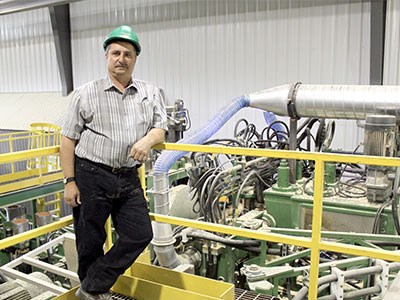Editor’s Note: This story originally appeared in the print edition of our July issue. Since then, another fire has occurred at the Timmins sawmill. On July 4, firefighters responded to a call about a blaze at the property, which sent up a black plume of smoke visible from several points in the city. No one was hurt in the fire, and operations are back up and running.
After a January, 2012, blaze burned Eacom’s sawmill in Timmins, shuttering it for a year and a half, the most common question fielded by general manager Guy Fleury was this: why didn’t you move it?
The mill is located in the core of downtown Timmins, and to outside observers, the fire, which caused $20 million in damage, presented the ideal opportunity to relocate the operation to a more industrial area, outside of the city’s parameters.
“If we had moved it off this site, a full facility — just this sawmill, without the stuff that didn’t burn, using some of the assets, and moving it — would have been $40 million,” Fleury said. “Without those assets at all, starting a mill is $50 million. But then add a planer, add a couple of kilns, add some site prep, and you’re quickly at $80 to $100 million for a full facility.”
Insurance covered $20 million worth of repairs, but Eacom invested an additional $10 million (for $30 million in total) to reuse some of the assets and rebuild on the site.
The fire didn’t burn everything; it primarily affected the dome-like Quonset, dating from 1970, which housed the main-line equipment. Smouldering sawdust, accumulated between the insulation and the dome’s tin roof, was difficult for firefighters to access. The equipment itself was damaged not by flames, but by the water used in the firefighting efforts.
“You can’t have equipment exposed to the elements for six months and expect to turn the key and have it run,” Fleury said.
Sawmilling has a long history on the site. The first mills started up along the river’s edge even before the town’s formation in 1912 and the current incarnation has changed hands four times. This is the third fire on the site; the others took place in the 1930s and 1950s.
The blaze did present Eacom with the opportunity to streamline its operation to ensure a more efficient line. Previously, after decades of building additions onto the existing facility, logs took a more circuitous, inefficient path down the line.
“Before, we had logs in, we debarked them, brought them all the way back and then started sawing them,” Fleury said. “We don’t do that now.”
The centrepiece of the entire operation is its vertical shaping saw (VSS), the most sophisticated technology on the market. Each log undergoes four 3D scans and is rotated to exact angles to determine how to glean the most fibre from it.
“We’re concentrating on recovery of fibre as opposed to volume, so the mill is made for more recovery with less fibre — as opposed to high-blast, high-volume — lowering your costs,” Fleury said.
And although the sorter wasn’t damaged in the fire, Eacom did invest in a newer version, replacing its 1980 model with a 1990 upgrade acquired from a shuttered mill in New Brunswick.
The mill runs a two-shift operation, 80 hours a week, while the rest of the time is reserved for maintenance. Since it’s been back up and running, the staff that had been off during the downtime has been recalled, although there has been a change in its makeup.
“Our modernization changed us by about 10 per cent, so 30 per cent less,” Fleury said. “Ten per cent was through attrition, and we rehired the other 20 per cent to have a full complement now.”
On site, the mill employs 120, only six or seven of whom are involved in operations, while others work in cleanup and maintenance. Another 300 employees work out in the field, cutting, planting and doing site prep.
Though operations are largely back to normal, the mill is still working to reach full capacity, something Fleury expects to achieve slowly, in small increments, over the next five or six months.
“It will take us until the fall and into the winter to get the line to the max,” he said. “Right now we are at about 90 per cent of pre-fire, and we intend to be at 120 per cent of pre-fire by the time all is said and done.”
The mill will need additional upgrades over the next few years. Replacement of a 1978 kiln will take place within three to four years, and the planer will need to be modernized. But otherwise, Fleury said, equipment manufacturer USNR “built us pretty much the mill we wanted. We’re satisfied with where we’re going so far with this and where it’s at.”
There are the usual challenges faced by the mill, including its close proximity to a residential neighbourhood, but Fleury said generally Eacom feels supported by the community.
And while mill closures of the last few years can make it easy to view the industry in a negative light, Fleury is actually quite optimistic about its future.
“There had to be a shift and adjustment in the forest industry; there were too many mills for the longest time,” he said. “So, while the industry seems to be decimated, it was probably a necessary evil in order for us to have thriving facilities and sustainable forest practices.”




